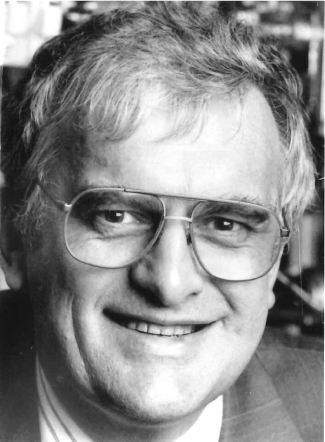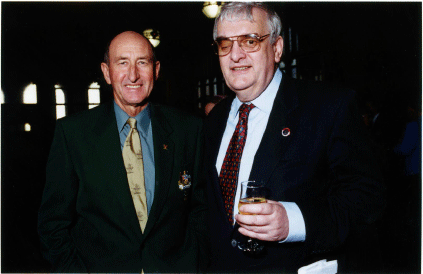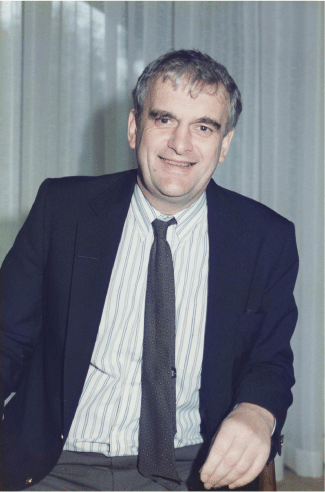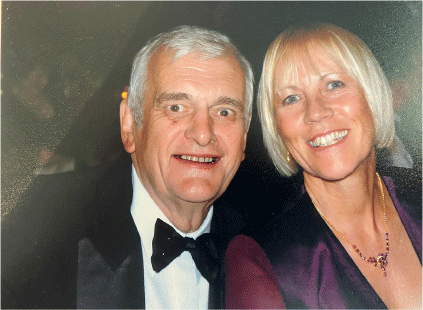Gavin Brown: 1942–2010
Anthony H. Dooley A *
A *
A
Abstract
Gavin Brown was a distinguished mathematician, born and educated in Scotland. He moved to Australia in 1975 and was a key contributor to the area of harmonic analysis at the University of New South Wales. Gavin’s career saw him become vice-chancellor of both the University of Adelaide and the University of Sydney, before he became the founding president of the Royal Institution of Australia. When Brown died in Adelaide on Christmas Day 2010, we lost a distinguished academic and research mathematician, a huge contributor to Australian education and society and a generous human being with a wonderful sense of humour.
Keywords: Gavin Brown, harmonic analysis, measure algebras, Royal Institution, vice-chancellor Sydney University.
Early life and university studies
Gavin was born in the small Scottish town of Lundin Links (Fife) on 27 February 1942. His parents were Alexandria D. Duncanson and Frank B.D. Brown, a bricklayer by trade. He was a brilliant student and went on to study at Madras College, St Andrews, where he was taught mathematics by John MacDonald, and was dux of the school in 1959.
After sitting the Bursary Examination of the University of St Andrews, he was awarded the university’s most prestigious scholarship, the Harkness Scholarship, and entered straight into second year mathematics. He continued to excel and graduated with First Class Honours in mathematics, applied mathematics and Latin in 1963, winning the Duncan Medal, again the most prestigious award to a graduating student.
Brown won a Carnegie scholarship to study at the University of Newcastle-upon-Tyne under the supervision of Frank Bonsall, one of the leaders of the North British Functional Analysis Group, and an eminent contributor to the development of the theory of Banach Algebras.1 He finished his PhD in 1966, entitled ‘Norm and stability properties of semi-algebras’.
Academic career
Immediately upon graduating, Gavin was appointed to the University of Edinburgh as a junior research fellow, and the first three papers2 from his thesis appeared through 1967 and 1969 on semi-algebras in Banach algebras. At the beginning of the academic year 1966–7 he was appointed to the University of Liverpool, as a lecturer, then promoted to senior lecturer. He remained at Liverpool until 1975, and during this time began a long and fruitful research relationship with William Moran3, who was a lifetime friend, and later followed him to Australia. During this time, he also spent the academic year 1967–8 as a visiting associate professor at the University of Illinois and the year 1974–5 at the University of Washington, where he began a collaboration with Edwin Hewitt.
In 1975, Gavin accepted a chair of pure mathematics at the University of New South Wales (UNSW), and he and his family emigrated to Sydney. He quickly became head of pure mathematics, and then head of the School of Mathematics and Statistics. He also continued his international collaborations, with appointments as visiting professor at the University of York in 1979 and at the University of Cambridge in 1986. During this period, the School of Mathematics and Statistics at UNSW grew in importance and influence, nationally and internationally. At the same time, Gavin’s research continued unabated, and he continued to receive Australian Research Council (ARC) grants, and to collaborate with a wider network internationally.
In 1989, Gavin was appointed dean of science at UNSW, succeeding Ted Buchwald. The faculty prospered under his leadership, and in 1992 he moved to the University of Adelaide as deputy vice-chancellor (Research). He then moved to the position of vice-chancellor which he held from 1994 to 1996: he was succeeded by Professor Mary O’Kane (Fig. 1).
Gavin Brown as vice-chancellor of the University of Adelaide (Source: © University of Adelaide).

On 1 July 1996, Brown became vice-chancellor of the University of Sydney, a post he held until his retirement in 2005 (Fig. 2). He left a lasting legacy at Sydney, which was somewhat dwindling in reputation and rankings when he took the position, but became one of the Australian leaders in university education and research during his tenure, and its budget returned to surplus.
Olympic runner Herb Elliott and vice-chancellor Gavin Brown (2000), [REF-00088403]. University of Sydney Archives.

Throughout this whole period, Brown continued a vigorous research program, producing around thirty papers in his time as vice-chancellor at Sydney. His research reached into the areas of probability, number theory, ergodic theory and harmonic analysis.
Gavin Brown retired as vice-chancellor on 10 July 2008, and moved back to Adelaide, where he established and became the inaugural director, Royal Institution of Australia, which he established as a major venue for communicating science to the public. He died a little over two years later. His last research publication appeared that year.
Major research contributions
Gavin’s initial mathematical research directions were from his supervisor, Frank Bonsall. An extremely well-known figure in mathematical analysis of that time, he worked in Banach algebras: his book with Duncan, published in 1973, remains a classic 50 years later. Interest in the area had arisen from the needs of physics and engineering, and also from the area of harmonic analysis, as convolution algebras on locally compact groups are perhaps the most studied examples. The key techniques were to use ideas from algebra, such as the structure of ideals in this area of analysis. Gavin’s first papers deal with the notion of semi-algebras in Banach algebras, and in his thesis, he was able to connect the existence of semi-algebras to the existence of wedges. He began working on convolution measure algebras, which complemented and extended his work on semi-algebras, and this led naturally into a string of papers on convolution measure algebras, starting in 1970, and thence into a major achievement in his papers with Bill Moran, where they characterised the structure of idempotents in compact monothetic semigroups. They moved on to study Bernoulli convolutions and Riesz products, moving into dichotomy theorems, which show that two of these measures are either mutually absolutely continuous or mutually singular. It is to be emphasised that the measures in question are all singular with respect to Lebesgue measure, and therefore outside the scope of our usual experience. These measures are linked to coin tossing experiments and therefore are closely associated to products of random variables in probability theory. Hence, this research became highly valued within a range of disciplines. Brown and Moran’s paper on dichotomy theorems for Riesz products gave a complete analogue of Kakutani’s celebrated dichotomy theorem for product measures, for this much richer and more complicated class of measures.4
When Brown moved to UNSW, he came in contact with researchers in operator algebras, and realised that the measures he had been studying were in fact ergodic for the odometer action, and that therefore they provided examples of the notoriously difficult Type III factors, which had been introduced by von Neumann some 30 years earlier. This led to the development of G-measures,5 related to equilibrium measures in statistical mechanics, and which were used to classify the types of von Neumann factors arising from actions where there is no equivalent invariant measure.
He continued to work on some difficult problems of classical harmonic analysis in work with Hewitt6 on convolution squares of singular measures, and with Moran on maximal elements in the maximal ideal space of measure algebras, the structure of radicals in convolution algebras via Raikov systems, and positivity results for trigonometric sums7: this theme continued until at least 2007. In a collaboration which began with Charles Pearce, he realised that Riesz products could be used to test the size of sets of normal numbers, and this led to a string of papers where his expertise on Riesz products was applied to number theory.8 He collaborated with Larry Shepp from Bell Labs on convolution inequalities used in communication theory,9 with Jacques Peyrière from Orsay on multifractal analysis of measures,10 and with Ferenc Móricz from Szeged on a range of results on the functional analysis of Hausdorff operators in L^p spaces.11 During his time as vice-chancellor at the University of Sydney, Gavin and Feng Dai wrote a series of articles12 about analysis and approximation of smooth functions on the sphere and other two-point homogeneous spaces, which have impact on such diverse areas as computer vision and weather prediction.
His last paper,13 published in the top Japanese journal Tohôku University Mathematics Journal, returned to his themes of Cantor measure, coin tossing and sum sets, making a fitting close to a dazzling intellectual contribution ranging over a wide tranche of modern harmonic and functional analysis, and which has had a great influence on many researchers and research programs.
Honours and distinctions
Professor Brown’s illustrious career led to many significant awards and distinctions. Following the significant scholarships and fellowships he received during his university career, Brown was awarded, in 1975, the Sir Edmund Whittaker Memorial Prize of the Edinburgh Mathematical Society. In 1982, he was the second recipient of the Australian Mathematical Society’s Medal ‘for distinguished research in the Mathematical Sciences’. In 1981, he was elected as a Fellow of the Australian Academy of Science, and went on to serve on its council from 1992 to 1995, becoming vice-president of the academy during 1992 and 1993 (Fig. 3). He was appointed as a corresponding member of the Royal Society of Edinburgh in March 2007.
Gavin Brown on his election to the Australian Academy of Science in 1982 (Source: Australian Academy of Science archives).

Throughout 1992 and 1993, he was also a member of the Australian Research Council; and chair of its advisory committees from 1988 to 1993. He became foundation chairman of the Go8 group of universities in 2000, president of the Pacific Rim Universities Forum 2006–8, the Australian representative at the United Nations Global Colloquium of University Presidents in Princeton in 2006, and the inaugural director of the Royal Institution in Australia in 2008.
He was awarded honorary degrees by the University of St Andrews in 1997, by the University of Dundee in 2004 and by the University of Sydney in 2009. In January 2006, he was appointed an Officer of the Order of Australia.
Contributions to Australian education and society
Gavin Brown had a transformational effect on every institution of which he was a member. As a leader, he had presence and gravitas, but it was leavened by a wonderful sense of humour, informed by an intellectual curiosity and accompanied by a refusal to accept anything at face value.
Within the sphere of mathematics, he quickly became a national leader and positioned UNSW as a key school of mathematics and statistics, focussing on mathematical analysis, applied mathematics and oceanography, and statistical sciences. He built the research performance of the school through a series of appointments and support for research grant funding, always showing leadership through his own research and teaching. He was an effective dean of the Faculty of Science, and introduced many new initiatives as the Faculty of Science amalgamated with the Faculty of Applied Science.
His move to the University of Adelaide first as deputy vice-chancellor (Research) and then as vice-chancellor was transformational in the history of the university, where he brought his expertise in development of research performance and his financial acumen to bear, bringing the university to a solid financial footing.
At the University of Sydney, he took over the management of a large and complex organisation which was in budget deficit, and rife with political division, and managed, over the course of his twelve-year tenure, to reassert its national leadership in each of the Australian Research Council categories, as well as in the National Health and Medical Research Council results. The university also increased its reputation in learning and teaching, measured by first preferences for local students and demand from overseas students. He oversaw a six-fold increase in research income, and was responsible for one of the largest capital works programs in the history of the university, upgrading the Eastern Mall, from a new information technology building at one end to the new law school building at the other. During this period, he contributed significantly to the overall development of intellectual life in Australia. Notably, he chaired the National Advisory Group on Science and Technology Awareness and Promotion, as well as numerous other national and regional committees.
As director of the Royal Institution in Adelaide, in his last years, he set up the Science Exchange in the old Stock Exchange Building. He envisaged the AU$27 million science hub as a place where maths and science could be discussed in a supportive atmosphere, whether it be to inspire youngsters and inform the general public, or to provide the science-minded with a forum for lively discussions over food and wine.
Upon his death, Glenn Withers, chief executive of Universities Australia said: ‘The universities of Australia have lost a great champion. Gavin Brown had the distinction of being vice-chancellor of both Adelaide and Sydney Universities. He helped transform each, while also promoting the wider cause of science and the contribution of universities to the wider community.’ Andrew Norton, adviser to minister Kemp during the Howard years, commented that Brown, like Alan Gilbert at Melbourne stood out among vice-chancellors as an original thinker.
How did he do this? Andrew Potter, spokesperson for professor Michael Spence, who succeeded Gavin Brown, commented that he had ‘an uncanny ability to back unconventional people and projects that became successful’. He certainly inspired loyalty and admiration from the academic staff, one dean of science at Sydney being heard to comment that he ‘was probably the cleverest person on campus’. Overall, he had a strategic intelligence which quickly saw to the heart of projects and of people and a unique capability to judge which ones would succeed and thrive. People around him could recognise this, and he brought them along with his vision.
Family life and interests
Gavin married Barbara Routh during his time at Liverpool, and they had two children, Colin and Janet, of whom he was immensely proud. Barbara was a huge support to him in his academic career and achievements, and her tragic death in 2001 was a massive blow to him. In 2004, he married Diané Ranck, and became step-father to her children Benjamin and Oliver (Fig. 4). They had a warm relationship, which was a true synergy between two remarkable individuals, and provided crucial support through his vice-chancellorship at the University of Sydney and his move to Adelaide to head up the Royal Institution. Diané became director of marketing at Flinders University and went on to become director of the State Theatre Company of South Australia. She now runs Creative Connectivity, a marketing company specialising in marketing strategy and building partnerships.
Gavin had a lifetime interest in horse-racing, and was able occasionally to escape from UNSW to Randwick racecourse. He was extremely quick at cryptic crosswords, had a huge vocabulary and an incisive and sometimes mischievous wit. Alongside this, he was a charming person with a truly strategic brain. The world will not look upon his like again.
Conflicts of interest
The author declares that there are no conflicts of interest in the preparation and publication of this article.
References
Brown, G. (1967) Relatively type 0 semi-algebras, Quarterly Journal of Mathematics Oxford Series, 18, 289-291.
| Crossref | Google Scholar |
Brown, G. (1968) Stability of wedges and semi-algebras, Mathematical Proceedings of the Cambridge Philosophical Society, 64, 365-376.
| Crossref | Google Scholar |
Brown, G. (1969) Norm properties of a class of semi-algebras, Journal of the London Mathematical Society, 44, 329-339.
| Crossref | Google Scholar |
Brown, G. (2010) Symmetric Cantor measure, coin-tossing and sum set, Tohôku Mathematical Journal, 62(4), 475-483.
| Crossref | Google Scholar |
Brown, G., and Dai, F. (2004) Approximation on two-point homogeneous spaces, Advances in Mathematics (China), 33(5), 635-638.
| Google Scholar |
Brown, G., and Dai, F. (2005) Approximation of smooth functions on compact two-point homogeneous spaces, Journal of Functional Analysis, 220, 2, 401-423.
| Crossref | Google Scholar |
Brown, G., and Dooley, A. H. (1985) Ergodic measures are of weak product type, Mathematical Proceedings of the Cambridge Philosophical Society, 98(1), 129-145.
| Crossref | Google Scholar |
Brown, G., and Dooley, A. H. (1991) Odometer actions on G-measures, Ergodic Theory and Dynamical Systems, 11(2), 279-307.
| Crossref | Google Scholar |
Brown, G., and Dooley, A. H. (1998) On G-measures and product measures, Ergodic Theory and Dynamical Systems, 18, 1, 95-107.
| Crossref | Google Scholar |
Brown, G., and Hewitt, E. (1968) Continuous singular measures equivalent to their convolution squares, Mathematical Proceedings of the Cambridge Philosophical Society, 80(2), 249-268.
| Crossref | Google Scholar |
Brown, G., and Hewitt, E. (1984) A class of positive trigonometric sums, Mathematische Annalen, 268(1), 91-122.
| Crossref | Google Scholar |
Brown, G., and Moran, W. (1972a) L-ideals of M(G) determined by continuity of translation, Proceedings of the Edinburgh Mathematical Society, 18, 307-316.
| Crossref | Google Scholar |
Brown, G., and Moran, W. (1972b) A dichotomy of infinite convolutions of discrete measures, Mathematical Proceedings of the Cambridge Philosophical Society, 73, 307-316.
| Crossref | Google Scholar |
Brown, G., and Moran, W. (1974) On orthogonality of Riesz products, Mathematical Proceedings of the Cambridge Philosophical Society, 76, 173-181.
| Crossref | Google Scholar |
Brown, G., and Moran, W. (1993) Schmidt’s conjecture on normality for commuting matrices, Inventiones Mathematica, 111, 3, 449-463.
| Crossref | Google Scholar |
Brown, G., and Móricz, F. (1999) Exact estimates for double Dirichlet series with nonnegative coefficient, Acta Mathematica Hungarica, 84(3), 199-208.
| Crossref | Google Scholar |
Brown, G., and Móricz, F. (2000) The Hausdorff and the quasi Hausdorff operators on the spaces Lp, 1 ≤ p < ∞, Mathematical Inequalities & Applications, 3(1), 105-115.
| Google Scholar |
Brown, G., and Móricz, F. (2002) Multivariate Hausdorff operators on the spaces Lp(Rn), Journal of Mathematical Analysis and Applications, 271(2), 443-454.
| Crossref | Google Scholar |
Brown, G., and Wilson, D. C. (1989) A class of positive trigonometric sums, II. Mathematische Annalen, 285(1), 57-74.
| Crossref | Google Scholar |
Brown, G., Michon, G., and Peyrière, J. (1992) On the multifractal analysis of measures, Journal of Statistical Physics, 66, 775-790.
| Crossref | Google Scholar |
Brown, G., Moran, W., and Pollington, A. D. (1993) Normality to noninteger bases, Comptes Rendus Academie des Sciences Paris Série I Mathématiques, 316(12), 1241-1244.
| Google Scholar |
Brown, G., Moran, W., and Pollington, A. D. (1997) Normality with respect to powers of a base, Duke Mathematical Journal, 88, 2, 247-265.
| Crossref | Google Scholar |
Brown, G., Moran, W., and Pollington, A. D. (2002a) Schmidt’s conjecture on normality for dimension two, Journal of Fourier Analysis and Applications, 8, 427-441.
| Crossref | Google Scholar |
Brown, G., Dai, F., and Sheng, S. Y. (2002b) Kolmogorov width of classes of smooth functions on the sphere Sd−1, Journal of Complexity, 18(4), 1001-1023.
| Crossref | Google Scholar |
Brown, G., Dai, F., and Móricz, F. (2004) The maximal Fejér operator on real Hardy spaces, Periodica Mathematica Hungarica, 49, 15-25 51.
| Crossref | Google Scholar |
Gillespie, T. A. (2020) Frank Featherstone Bonsall. 31 March 1920—22 February 2011, Biographical Memoirs of Fellows of the Royal Society, 69, 63-77.
| Crossref | Google Scholar |
Footnotes
2 Brown (1967, 1968, 1969).
3 Brown and Moran (1972a, 1972b). Between 1971 and 1973, Brown and Moran produced 11 papers, appearing in some of the top British journals for mathematical analysis.
13 Brown (2010).



